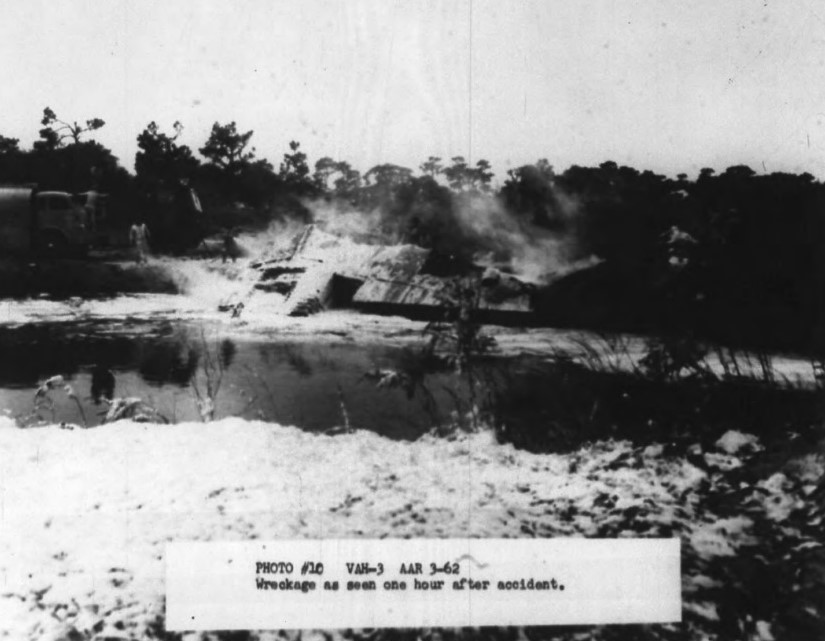
This information is added by users of ASN. Neither ASN nor the Flight Safety Foundation are responsible for the completeness or correctness of this information.
If you feel this information is incomplete or incorrect, you can submit corrected information.
| Date: | Tuesday 27 November 1962 |
| Time: | 14:14 |
| Type: |  North American A-5A Vigilante |
| Owner/operator: | United States Navy (USN) |
| Registration: | 148927 |
| MSN: | |
| Fatalities: | Fatalities: 0 / Occupants: 1 |
| Other fatalities: | 0 |
| Aircraft damage: | Destroyed |
| Location: | NAS Sanford, FL -
 United States of America United States of America
|
| Phase: | Take off |
| Nature: | Military |
| Departure airport: | NAS Sanford, FL |
| NAS Sanford, FL | |
| Confidence Rating: |
Written off at NAS Sanford, FL after overrunning runway 27, crashing thru the blast deflector, running over a RR track into a small pond and catching fire. Pilot escaped (no ejection). Pilot was likely on FAM-1 training flight, which is a runway run with afterburner, and could not stop in time.
Accident occurred during T/O roll on Runway 27 at NAS Sanford with the pilot flying alone. He was taking off 30 seconds behind another A-5 for a scheduled formation and FMLP flight. Crosswind was NNW at 12 knots gusting to 17. As the aircraft became airborne after 3,000’ of roll the left wing dropped and the aircraft yawed to the left. The pilot noted a drop in port engine EGT and then it returned to normal. He aborted the T/O. Throttles were retarded to military, then to idle, and he re-landed. The pilot dropped the hook but it failed to engage both abort wires at a speed of 120 knots. Realizing he missed the wires the pilot applied heavy braking resulting in fire and smoke from both main wheels. At 105 knots the Vigilante crossed onto the overrun. The pilot secured the engines as the aircraft veered right and crashed head-on into the blast fence. The aircraft appeared to explode, it then proceeded across a small road burning and disintegrating, then through a perimeter cyclone fence. It finally crossed a railroad embankment and landed on the far bank of an excavation engulfed in flames. The pilot blew the canopy and escaped, sheltering behind the embankment. The aircraft was partially submerged in water and suffered strike damage.
The aircraft had broken apart aft of the rear cockpit. The front cockpit was nearly intact. The aircraft burned extensively for 30 minutes aft of the rear cockpit except for that which was submerged in the water. The pilot had blown the canopy off, disconnected his rocket jet fittings, but was held up by his oxygen hose. He removed his helmet and ran behind the railroad embankment.
Possible factors were the maximum allowable crosswind component and the pilot elected to abort after lift-off rather than continue. Arresting wires were also too low to the ground – the hook point would’ve over-rode the cable.
RVAH-3 Pilot Lt. W. L. Goodman
148927 had been accepted on 12 February 1962 and crashed with 259.7 total flight hours.
Sources:
http://www.forgottenjets.warbirdsresourcegroup.org/A-5.html
US Navy accident report.
Location
Images:

Revision history:
| Date/time | Contributor | Updates |
|---|---|---|
| 14-Jan-2022 20:52 | TB | Updated [Operator, Total fatalities, Other fatalities] |
| 19-Jul-2022 18:56 | Anon. | Updated [Total occupants, Narrative] |
| 05-Jun-2024 09:48 | ChrisB | Updated [Time, Phase, Departure airport, Destination airport, Source, Narrative, Category, Photo] |
Corrections or additions? ... Edit this accident description
The Aviation Safety Network is an exclusive service provided by:


 ©2024 Flight Safety Foundation
©2024 Flight Safety Foundation